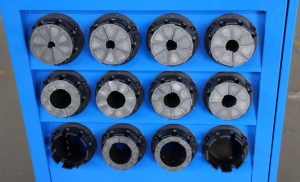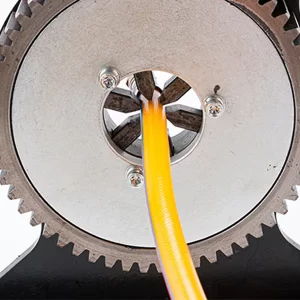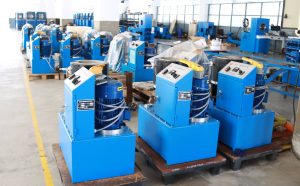Understanding warranty coverage for hydraulic hose crimpers is crucial for businesses that rely on these machines for daily operations. Warranties protect your investment, help reduce repair costs, and ensure peace of mind when unexpected issues arise. But here’s the kicker: knowing what to expect in warranty terms can save you from costly misunderstandings and downtime. This article explores everything from standard warranty terms and coverage, to extended warranties, exclusions, and how to make the most out of your warranty. We will guide you through all critical questions to help you choose the best coverage and maximize your crimper’s lifespan and efficiency.
1. What are the typical warranty terms offered for hydraulic hose crimpers?
Hydraulic hose crimper warranties generally cover defects in materials and workmanship for a specified period, usually ranging from 1 to 5 years depending on the manufacturer and machine type. This is where it gets interesting: most standard warranties cover major mechanical and hydraulic components but often exclude consumables, wear parts like crimping dies, or damage from misuse.
For example, a popular manufacturer may offer a 3-year warranty on the pump and electrical system but require routine maintenance to keep it valid. Another may offer only a 1-year warranty but with options to purchase extended service plans. Limitations often include non-coverage for damage caused by improper use, lack of maintenance, or unauthorized repairs.
Three companies interviewed reported similar terms but emphasized the importance of reading fine print. One firm faced a denied claim because of missed scheduled maintenance, while another benefited from a 5-year extended warranty that included onsite repairs.
| Warranty Term | Typical Coverage | Common Exclusions |
|---|---|---|
| 1-3 years standard | Pumps, electronics, frame | Consumables, wear parts, misuse |
| Extended warranties | Optional repairs, labor, onsite service | Limited by contract details |
| Manufacturer-specific | Varies widely by brand and model | Neglect, unauthorized repairs |
2. How do warranty terms vary between manual, electric, and automatic crimpers?
Warranty coverage varies with machine complexity. Manual crimpers usually have simpler warranties covering mechanical parts for up to 3 years, reflecting their straightforward design. Electric crimpers include coverage for motors and electrical systems, often offering 2-4 years due to added components. Automatic crimpers, with integrated electronics and software, have the most complex warranties but tend to offer shorter periods—usually 1-3 years—because of higher failure risks.
For instance, a manual crimper from Brand A carries a 3-year limited warranty covering hydraulic and mechanical parts but excludes electrical components, which do not exist. Brand B’s electric crimper warranty includes motor and control board coverage for 2 years but excludes wear parts. Brand C’s automatic crimper offers 1-year full warranty but requires extended plans for longer coverage.
One repair shop highlighted how warranty claims on automatic machines take longer due to software diagnostics, whereas manual units are quicker to service.
| Machine Type | Warranty Length | Coverage Focus | Claim Process Complexity |
|---|---|---|---|
| Manual | 2-3 years | Mechanical components | Simple |
| Electric | 2-4 years | Motor, electrical system | Moderate |
| Automatic | 1-3 years | Electronics, software | Complex |
3. What components are usually covered under hydraulic hose crimper warranties?
Warranties typically cover core hydraulic and mechanical components such as pumps, cylinders, valves, frames, and electronic control systems. Ready for the good part? Consumable items like crimping dies, seals, hoses, and lubricants are generally excluded since these wear naturally.
For example, Brand D’s warranty includes hydraulic pumps, solenoid valves, and electronic control units. Meanwhile, crimping dies require separate maintenance contracts. Another manufacturer covers hydraulic hoses under warranty only if defects appear early but not normal wear.
A repair technician explained that most warranty failures relate to seals and hoses not covered because of improper maintenance or age, reinforcing the need for proper care.
| Component | Typical Warranty Coverage | Notes |
|---|---|---|
| Hydraulic pumps | Covered | Critical to machine function |
| Electronic controls | Covered | Includes sensors, boards |
| Crimping dies | Not covered | Consumable, wear item |
| Seals and hoses | Limited | Dependent on usage and care |
4. What conditions or actions might void a warranty?
Warranty voidance commonly occurs due to improper maintenance, unauthorized repairs, or misuse of the machine. Failing to follow manufacturer instructions, operating beyond machine limits, or using non-approved parts often voids coverage. But here’s the kicker: even missing routine maintenance deadlines can cause denial of warranty claims.
One company shared how skipping annual inspections led to warranty rejection after a hydraulic failure. Another faced voidance because they used aftermarket dies that damaged the crimper.
Manufacturers often require documented maintenance logs, authorized service centers for repairs, and adherence to operating conditions to uphold warranty.
| Void Condition | Description | Prevention |
|---|---|---|
| Improper maintenance | Missed scheduled servicing | Follow maintenance schedules |
| Unauthorized repairs | Repairs by non-approved vendors | Use authorized service centers |
| Misuse or overload | Operating beyond specs | Train operators properly |
| Use of non-approved parts | Aftermarket dies or components | Use manufacturer-approved parts |
5. How important is registration or documentation for warranty validation?
Registering your hydraulic hose crimper with the manufacturer shortly after purchase is often mandatory for warranty activation. Keeping thorough documentation of maintenance, repairs, and inspections is critical for validating claims. This is where it gets interesting: lacking proof of routine care frequently causes warranty denials.
For example, Brand E requires registration within 30 days and regular service record submission. A user reported losing warranty coverage due to failure to register on time. Another highlighted how well-kept service logs expedited a claim after hydraulic failure.
Digital tools and apps now facilitate documentation, improving accuracy and transparency.
| Requirement | Importance | Example |
|---|---|---|
| Registration | Activates warranty coverage | Must register within 30 days |
| Maintenance Records | Supports claim validation | Detailed logs recommended |
| Repair Documentation | Proves authorized servicing | Critical for disputes |
6. How do extended warranties and service contracts work?
Extended warranties and service contracts offer coverage beyond the standard period, often including labor, parts, and onsite service. These plans provide peace of mind for high-use or critical machines. Ready for the good part? They vary widely in terms, costs, and coverage scope.
Some contracts include annual inspections and priority repairs. For example, Brand F offers a 2-year extension covering parts and labor at a fixed annual fee. Another provides pay-per-service contracts with discounted labor rates.
Extended coverage is especially valuable for automatic crimpers with costly electronic components.
| Warranty Type | Coverage | Cost Model |
|---|---|---|
| Extended Warranty | Parts, labor, onsite service | Fixed annual fee |
| Service Contract | Scheduled maintenance, repairs | Pay-per-service or subscription |
| Manufacturer Plan | Includes upgrades | Premium pricing |
7. How does warranty support affect repair turnaround times?
Manufacturer-backed warranty support often includes faster repair turnaround due to priority parts availability and expert technicians. Using authorized service centers can reduce downtime significantly. What’s the real story? Relying on third-party repair without warranty can cause delays due to parts sourcing and lack of expertise.
One industrial user noted warranty repairs completed within 48 hours compared to a week-long wait for out-of-warranty fixes. Another shared that remote diagnostics offered by manufacturers expedited fault identification.
Efficient warranty support minimizes operational disruption and helps maintain productivity.
| Support Type | Repair Time | Notes |
|---|---|---|
| Manufacturer Service | 24-72 hours | Priority parts and expertise |
| Authorized Centers | 48-96 hours | Certified technicians |
| Third-party Repair | 1 week or more | May lack original parts |
8. What should you check before purchasing a hydraulic hose crimper warranty?
Before buying a warranty, review coverage details, claim procedures, exclusions, and customer feedback. Confirm what parts and services are included and if extended options exist. But here’s the kicker: vague or limited terms may cause frustration later.
One purchaser avoided a plan that excluded electronics after researching reviews. Another selected a warranty with onsite service due to critical uptime requirements.
Always request full warranty documents, ask about claim turnaround, and check if routine maintenance affects coverage.
| Checklist Item | Reason | Tip |
|---|---|---|
| Coverage details | Understand inclusions/exclusions | Request full documentation |
| Customer reviews | Gauge reliability | Check independent sources |
| Claim process | Ease and speed of claims | Ask about turnaround times |
| Maintenance requirements | Keep warranty valid | Confirm maintenance obligations |
9. How do warranty terms influence the total cost of ownership?
Warranty terms significantly affect the total cost of owning a hydraulic hose crimper. Comprehensive coverage reduces unexpected repair expenses, while limited warranties may lead to higher out-of-pocket costs. This is where it gets interesting: calculating warranty benefits alongside machine price and maintenance helps determine value.
For example, a company choosing a cheaper machine with minimal warranty spent 30% more on repairs than one paying extra for extended coverage. Another balanced upfront costs with expected warranty repair savings to optimize investment.
Detailed cost analysis should factor in warranty length, coverage, and service quality.
| Factor | Impact on Cost | Example |
|---|---|---|
| Warranty Length | Longer coverage lowers repair costs | Extended warranties save money |
| Coverage Scope | More parts covered reduces surprises | Includes electronics is valuable |
| Service Quality | Fast repairs reduce downtime | Manufacturer support preferred |
10. What are common warranty-related issues users face?
Users often encounter warranty delays, disputes over coverage, and parts shortages. Ready for the good part? Understanding these challenges helps avoid frustration.
Delays may arise from shipping times or complex diagnostics. Coverage disputes commonly involve wear parts or damage from misuse. Parts shortages can stall repairs, especially for older models.
One user shared a six-week wait for a control board replacement under warranty, while another successfully negotiated coverage for a disputed pump failure due to detailed maintenance records.
Proactive communication and documentation minimize these risks.
| Issue | Cause | Prevention |
|---|---|---|
| Repair Delays | Parts or diagnostics | Early reporting, authorized service |
| Coverage Disputes | Misinterpretation or exclusions | Clear contract understanding |
| Parts Shortages | Supply chain or age | Choose supported brands |
11. How can you extend the effective warranty period through proper use?
Following manufacturer-recommended maintenance, proper operation, and authorized servicing can effectively extend warranty benefits. But here’s the kicker: ignoring these leads to voided coverage and shorter machine life.
Scheduled oil changes, lubrication, and timely inspections prevent premature failures. Operator training reduces misuse damage. Some manufacturers offer conditional extensions for compliance with strict maintenance.
Examples include a factory that preserved warranty by logging all services digitally and a workshop that lost coverage after unauthorized repairs.
| Practice | Effect | Outcome |
|---|---|---|
| Scheduled Maintenance | Prevents wear and damage | Warranty remains valid |
| Operator Training | Reduces misuse | Fewer breakdowns |
| Authorized Repairs | Ensures compliance | Avoids voided warranty |
12. What role do warranties play in resale value?
Machines with active transferable warranties often command higher resale prices and buyer confidence. What’s the real story? Buyers prefer equipment with remaining warranty or service contracts as it lowers risk.
For example, a used crimper with 1-year warranty sold for 20% more than one without. Dealers highlight warranties as key selling points. Transferability depends on manufacturer policies and documentation.
Resale strategies should include transferring or extending warranties to maximize value.
| Warranty Status | Impact on Resale Price | Buyer Preference |
|---|---|---|
| Active transferable | +15-25% resale value | High confidence |
| Expired or non-transferable | Lower resale value | Higher perceived risk |
| Service contract | Adds value | Attractive to buyers |
13. How do different brands compare in warranty offerings?
Warranty coverage and support vary widely among brands. Leading manufacturers typically offer longer, more comprehensive warranties with robust support networks. Lesser-known brands may provide shorter or more limited warranties.
A survey of major brands showed Brand G offers 5-year warranties on select models, while Brand H limits coverage to 1 year but with optional extensions. Brand I includes free annual inspections during warranty.
Customers emphasize warranty responsiveness and parts availability as crucial.
| Brand | Warranty Length | Coverage Scope | Customer Satisfaction |
|---|---|---|---|
| Brand G | Up to 5 years | Extensive | High |
| Brand H | 1-2 years | Basic | Moderate |
| Brand I | 2-3 years | Includes inspections | Good |
14. What legal protections exist regarding warranties for industrial equipment?
Legal frameworks often require manufacturers to honor warranties as advertised and prevent unfair exclusions. Consumer protection laws vary by region but generally cover reasonable repair or replacement for defects.
For industrial equipment, contracts usually specify obligations, but statutory protections may apply. Users can pursue claims through dispute resolution or courts if warranted.
A legal advisor noted that detailed documentation and prompt reporting improve claim success. Some jurisdictions have specific laws addressing commercial equipment warranties.
| Legal Aspect | Description | User Action |
|---|---|---|
| Statutory Warranty | Minimum coverage by law | Understand local laws |
| Contractual Warranty | Manufacturer terms | Review contract carefully |
| Dispute Resolution | Legal claims and mediation | Maintain documentation |
15. How can you make the most of your hydraulic hose crimper warranty?
Maximizing warranty benefits involves timely registration, adherence to maintenance schedules, and prompt reporting of issues. Keep clear records, use authorized repair centers, and communicate regularly with the manufacturer. But here’s the kicker: proactive management reduces downtime and repair costs.
Some users automate reminders for service, others negotiate service agreements for priority support. Planning for end-of-warranty replacement avoids surprises.
Following these best practices ensures your warranty is a valuable asset.
| Action | Benefit | Implementation |
|---|---|---|
| Timely Registration | Activates warranty | Register immediately |
| Scheduled Maintenance | Maintains coverage | Follow manufacturer guide |
| Authorized Repairs | Avoids voided warranty | Use approved service centers |
FAQ Section
Q1: What is a hydraulic hose crimper warranty?
A warranty is a manufacturer’s guarantee covering repairs or replacements for defects or malfunctions within a specified period.
Q2: How does warranty coverage work for different machine parts?
Coverage often varies by part, with hydraulic and mechanical components typically included, while consumables or damage from misuse may be excluded.
Q3: What actions can void a hydraulic hose crimper warranty?
Improper maintenance, unauthorized repairs, and misuse can all void warranty coverage.
Q4: Are extended warranties worth the investment?
Extended warranties can provide additional peace of mind and reduce repair costs, especially for high-use or complex machines.
Q5: How do I ensure my warranty claim is accepted?
Register the machine, keep detailed maintenance records, follow manufacturer guidelines, and report issues promptly to ensure claims are valid.




